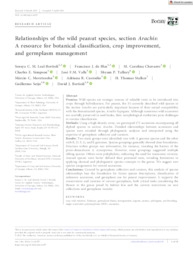Relationships of the wild peanut species, section Arachis: a resource for botanical classification, crop improvement, and germplasm management.
Relationships of the wild peanut species, section Arachis: a resource for botanical classification, crop improvement, and germplasm management.
Author(s): LEAL-BERTIOLI, S. C. M.; BLAS, F. J. de; CHAVARRO, M. C.; SIMPSON, C. E.; VALLS, J. F. M.; TALLURY, S. P.; MORETZSOHN, M. de C.; CUSTODIO, A. R.; STALKER, H. T.; SEIJO, G.; BERTIOLI, D. J.
Summary: Premise Wild species are strategic sources of valuable traits to be introduced into crops through hybridization. For peanut, the 33 currently described wild species in the section Arachis are particularly important because of their sexual compatibility with the domesticated species, Arachis hypogaea. Although numerous wild accessions are carefully preserved in seed banks, their morphological similarities pose challenges to routine classification. Methods Using a high-density array, we genotyped 272 accessions encompassing all diploid species in section Arachis. Detailed relationships between accessions and species were revealed through phylogenetic analyses and interpreted using the expertise of germplasm collectors and curators. Results Two main groups were identified: one with A genome species and the other with B, D, F, G, and K genomes. Species groupings generally showed clear boundaries. Structure within groups was informative, for instance, revealing the history of the proto-domesticate A. stenosperma. However, some groupings suggested multiple sibling species. Others were polyphyletic, indicating the need for taxonomic revision. Annual species were better defined than perennial ones, revealing limitations in applying classical and phylogenetic species concepts to the genus. We suggest new species assignments for several accessions. Conclusions Curated by germplasm collectors and curators, this analysis of species relationships lays the foundation for future species descriptions, classification of unknown accessions, and germplasm use for peanut improvement. It supports the conservation and curation of current germplasm, both critical tasks considering the threats to the genus posed by habitat loss and the current restrictions on new collections and germplasm transfer.
Publication year: 2024
Types of publication: Journal article
Observation
Some of Embrapa's publications are published as ePub files. To read them, use or download one of the following free software options to your computer or mobile device. Android: Google Play Books; IOS: iBooks; Windows and Linux: Calibre.
Access other publications
Access the Agricultural Research Database (BDPA) to consult Embrapa's full library collection and records.
Visit Embrapa Bookstore to purchase books and other publications sold by Embrapa.

